The Intelligent Fencing Market is estimated to be valued at USD 709.5 million in 2025 and is projected to reach USD 1319.3 million by 2035, registering a compound annual growth rate (CAGR) of 6.4% over the forecast period.
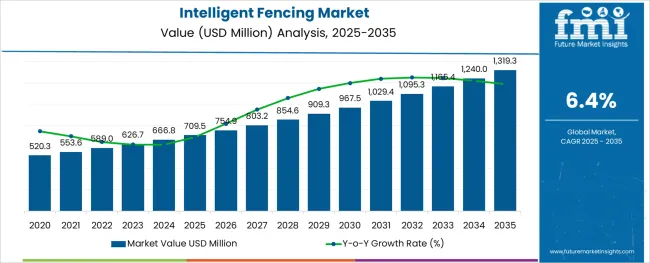
The intelligent fencing market is advancing steadily as security systems evolve from passive barriers to active, sensor-driven protection frameworks. Growing concerns over property intrusions, theft, and vandalism are prompting wider adoption of intelligent fencing solutions that integrate motion sensors, surveillance cameras, AI-based analytics, and centralized control systems.
In residential and commercial settings alike, intelligent fences are increasingly being tied to broader smart home and smart facility ecosystems, offering real-time alerts, remote access, and predictive threat detection. Technological progress in low-power wide-area networks, edge processing, and weather-resistant materials is expanding deployment possibilities across diverse terrains and climates.
Regulatory focus on infrastructure safety and urban planning guidelines is also encouraging builders and property developers to include smart perimeter security by default. As end users seek customizable, energy-efficient, and tamper-resistant security solutions, the intelligent fencing market is poised to gain traction in both high-density urban environments and remote or rural installations.
The market is segmented by End User and region. By End User, the market is divided into Residential, Commercial, Government, and Others. Regionally, the market is classified into North America, Latin America, Western Europe, Eastern Europe, Balkan & Baltic Countries, Russia & Belarus, Central Asia, East Asia, South Asia & Pacific, and the Middle East & Africa.
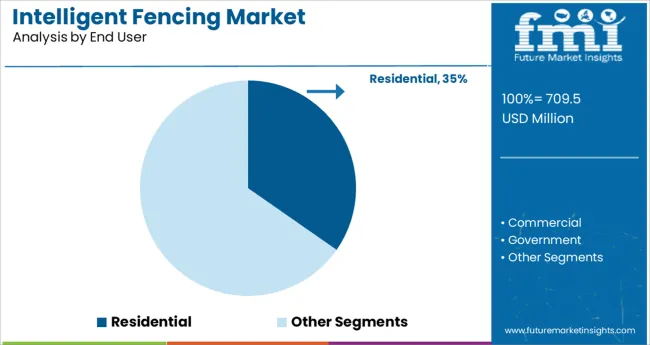
The residential segment is projected to account for 34.7% of the total intelligent fencing market revenue in 2025, making it the leading end user category. This leadership is attributed to the rising demand for integrated home security systems that offer automated alerts, real-time surveillance, and intrusion detection.
Homeowners are increasingly investing in intelligent fencing solutions as part of smart home ecosystems, with compatibility across mobile devices, voice assistants, and cloud-based monitoring platforms. The adoption of solar-powered sensors and wireless connectivity has made installation more accessible, particularly in standalone homes and gated communities.
Furthermore, increasing crime rates and heightened awareness about perimeter safety have driven uptake across both new constructions and retrofitted residential properties. Intelligent fencing in the residential context is also being favored for its aesthetic flexibility, enabling discreet integration without compromising the visual appeal of the premises. This convergence of safety, convenience, and design adaptability has reinforced the segment’s dominant position in the market.
The increasing demand for intelligent fencing systems for warehouse storage centers, security, and farmland security is one of the major factors that is expected to propel the growth of the intelligent fencing market over the analysis period.
Another major factor responsible for the market growth includes the rise in safety and security concerns and spending carried out for commercial and government constructions.
Various advantages of intelligent fencing over alarm systems and CCTV surveillance are boosting the growth of the intelligent fencing market. The intelligent fencing market is witnessing high growth due to the increase in government spending for enhancing public places, and government premises.
The usage of intelligent fencing by armed forces to seal international borders is another factor that is expected to accelerate the growth of the intelligent fencing market in the forthcoming years. Moreover, the increasing adoption of the product from farm owners to secure land from wild animals by creating a barrier that keeps farms safe from any intrusion is anticipated to fuel market growth in the near future.
One of the critical challenges in the Intelligent Fencing market is the vulnerability to cyber-attacks. In addition, device and system compatibility is also a major challenge that is expected to impede the growth of the Intelligent Fencing market during the forecast period.
The high cost of intelligent fencing and maintenance associated with replacing the intelligent fencing is expected to hinder the growth of the Intelligent Fencing Market. The high maintenance cost is associated with the requirement to spreading fences across international borders and maintain regular inspections to ensure optimum usability.
Owing to the high maintenance costs, the end-users are looking for other alternatives such as unmanned systems which is another factor challenging the market growth.
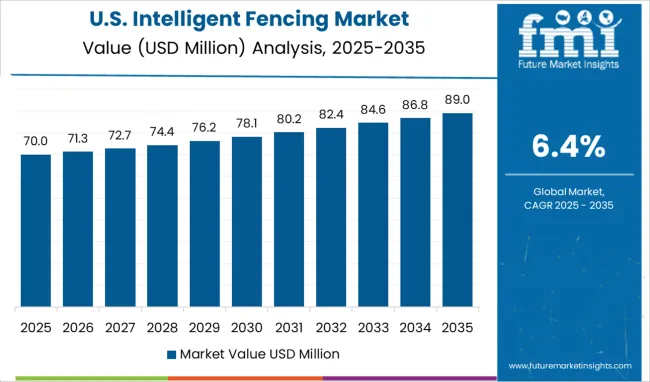
In terms of regional platforms, North America holds the largest market share in the Intelligent Fencing market. The region is expected to surge to over 27.2% share from 2025 to 2035.
North America is expected to fuel the Intelligent Fencing market, attributed to the presence of a large number of electric fence providers along with the large defense spending by the US in the region.
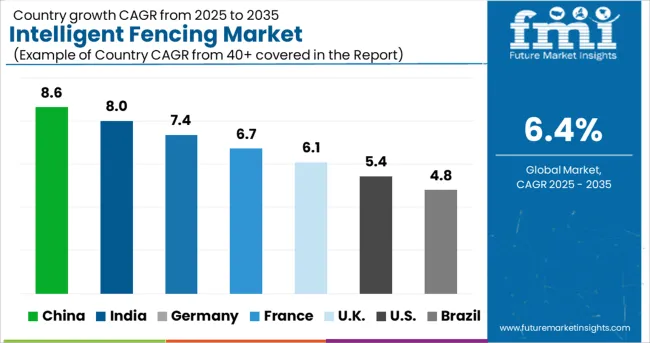
According to Future Market Insights, Europe is expected to hold significant growth opportunities for Intelligent Fencing and is expected to reach the highest share of 19.9% in 2025.
Europe is expected to register a significant share during the forecast period. The increasing adoption of intelligent fencing for homeland security is driving the growth of the market in the region.
According to Future Market Insights, Asia-Pacific is expected to grow with lucrative growth opportunities for Intelligent Fencing Market and is expected to reach the highest share of 19.4% in 2025.
Asia-Pacific region accounts for a significant share of the Intelligent Fencing Market, attributed to the rising defense budgets from developing economies such as India and China and large agriculture industries in the region, which are anticipated to propel the growth of the market.
According to Future Market Insights, the Middle East & Africa are expected to provide significant growth opportunities for Intelligent Fencing Market and are expected to reach a share of 13.7% in 2025.
The increasing use of fencing for border security to restrain the smuggling of goods and drug activities are likely to fuel the growth of the intelligent fencing market in the Middle East & Africa.
There are many prominent market players in the Intelligent Fencing Market such as Dare Products, High Tech Pet, Kencove, Parker McCrory Mfg Co., PetSafe, Premier1Supplies, Woodstream, Datamars SA, AMAROK, LLC, and Nemtek, among others, that are working hand-in-hand to provide the best-in-class Intelligent Fencing for enhancing the global arena.
However, there are many global start-ups in the Intelligent Fencing Market, that are stepping forward in matching the requirements of the Intelligent Fencing domain.
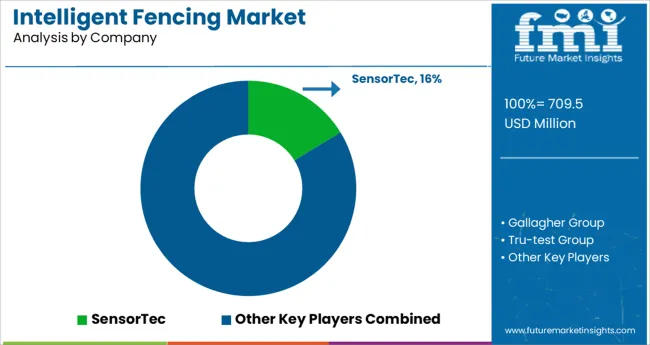
Some of the key participants present in the global Intelligent Fencing market include SensorTec, Gallagher Group, Tru-test Group, Smart Fence integrated Security, Betafence NV, Long Fence, CertainTeed, ST Microelectronics, and NXP semiconductors, among others.
Attributed to the presence of such a high number of participants, the market is highly competitive. While global players such as SensorTec, Gallagher Group, Tru-test Group, and Smart Fence integrated Security account for a considerable market size, several regional-level players are also operating across key growth regions, particularly in North America.
Recent Development:
| Report Attribute | Details |
|---|---|
| Growth Rate | CAGR of 6.4% from 2025 to 2035 |
| Market Value in 2025 | USD 709.5 million |
| Market Value in 2035 | USD 1319.3 million |
| Base Year for Estimation | 2024 |
| Historical Data | 2020 to 2024 |
| Forecast Period | 2025 to 2035 |
| Quantitative Units | Revenue in million and CAGR from 2025 to 2035 |
| Report Coverage | Revenue Forecast, Volume Forecast, Company Ranking, Competitive Landscape, Growth Factors, Trends, and Pricing Analysis |
| Segments Covered |
Product Type, Application, Region |
| Regions Covered |
North America; Latin America; Europe; Asia Pacific; Middle East and Africa |
| Key Countries Profiled | United States of America, Canada, Brazil, Argentina, Germany, United Kingdom, France, Spain, Italy, Nordics, Belgium, Netherlands, Luxembourg, Poland, Russia, Australia & New Zealand, China, India, ASIAN, GCC Countries, South Africa |
| Key Companies Profiled | SensorTec; Gallagher Group; Tru-test Group; Smart Fence Integrated Security; Betafence NV; Long Fence; CertainTeed; ST Microelectronics; and NXP semiconductors; among others. |
| Customization | Available Upon Request |
The global intelligent fencing market is estimated to be valued at USD 709.5 million in 2025.
It is projected to reach USD 1,319.3 million by 2035.
The market is expected to grow at a 6.4% CAGR between 2025 and 2035.
The key product types are residential, commercial, government and others.
segment is expected to dominate with a 0.0% industry share in 2025.






Full Research Suite comprises of:
Market outlook & trends analysis
Interviews & case studies
Strategic recommendations
Vendor profiles & capabilities analysis
5-year forecasts
8 regions and 60+ country-level data splits
Market segment data splits
12 months of continuous data updates
DELIVERED AS:
PDF EXCEL ONLINE
Intelligent Completion Market Size and Share Market Forecast and Outlook 2025 to 2035
Intelligent Rubber Tracks Market Size and Share Forecast Outlook 2025 to 2035
Intelligent Cervical Massager Market Size and Share Forecast Outlook 2025 to 2035
Intelligent Garment Hanging Conveyor System Market Size and Share Forecast Outlook 2025 to 2035
Intelligent Rotary Kiln Monitoring Systems Market Size and Share Forecast Outlook 2025 to 2035
Intelligent Multifunctional Laser Bird Repeller Market Size and Share Forecast Outlook 2025 to 2035
Intelligent Platform Management Interface (IPMI) Market Size and Share Forecast Outlook 2025 to 2035
Intelligent Flow Meter Market Size and Share Forecast Outlook 2025 to 2035
Intelligent Lighting Control Market Size and Share Forecast Outlook 2025 to 2035
Intelligent Enterprise Data Capture Software Industry Analysis in Japan Size and Share Forecast Outlook 2025 to 2035
Intelligent Vending Machine Market Insights – Demand, Size & Industry Trends 2025–2035
Intelligent Transportation System Market Analysis - Size, Share, and Forecast Outlook 2025 to 2035
Intelligent Virtual Store Design Solution Market Size and Share Forecast Outlook 2025 to 2035
Intelligent Enterprise Data Capture Software Market Size, Growth, and Forecast 2025 to 2035
Intelligent Packaging Market Analysis - Size, Share, and Forecast Outlook 2025 to 2035
Intelligent Enterprise Data Capture Software Market in Korea – Trends & Forecast 2025 to 2035
Intelligent Power Module Market Trends - Growth & Forecast 2025 to 2035
Intelligent Prosthetics Market Analysis - Size, Share, and Forecast 2025 to 2035
Intelligent Traffic Management Market Trends – Growth & Forecast 2024 to 2034
Intelligent Motor Control Market

Thank you!
You will receive an email from our Business Development Manager. Please be sure to check your SPAM/JUNK folder too.
Chat With
MaRIA